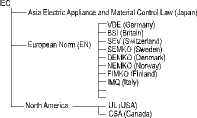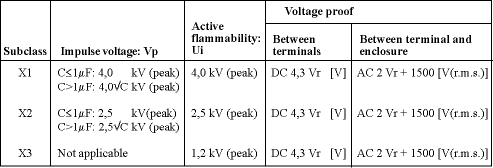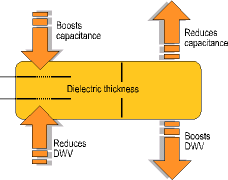
Safety capacitors have existed for so long that we tend to take them for granted, and assume that not much is happening. Not true! In ceramic technology, a great deal has happened over the years and more is happening now.
The humble safety capacitor lives in a harsh electrical environment. X capacitors sit directly across incoming AC supply lines, and Y capacitors between the lines and ground, all having to survive whatever the outside world throws at them. Even if they have the benefit of high quality AC supplies, they may still be subject to surges and fluctuations in voltage, phase angle or current - their prime reason for being there.
Safety standards
With the objective of protecting users from fire, electrocution and associated risks, safety capacitors, are appropriate candidates for standardisation. Sadly, this has been a minefield, with at least eight bodies in Europe evolving individual standards, often with significant differences for the same test. This was compounded by equally valid standards in North America and Asia. Happily, these are now more or less standardised under IEC (see Figure 1).

Among the stringent tests required for recognition and ongoing quality control are: flammability, impulse voltage, plus dielectric and insulation breakdown, the severity depending on the class in the standard to which the component is recognised. There are three levels for type X (X1/ X2/ X3) and four similarly-numbered for type Y. Details are summarised in Tables 1 and 2, full details in IEC384-14 2nd edition.


Historical limitations
The predominant construction for safety capacitors has been the leaded, single-plate ceramic disk, in 'medium k' dielectric. Over the years various materials have been used for the outer coating. The earlier, phenolic-coated types struggled to meet the dielectric breakdown tests, especially when the separate test for the outer coating was first introduced. Newer materials and processes have eliminated these difficulties.
Capacitance values have generally remained between 10 pF and 4700 pF, the stress being on smaller devices rather than higher values. Other pressures have been on increasing mechanical accuracy of lead-pitch and taping so that insertion machines could run faster while inserting parts in smaller spaces. However, dimensional accuracy of PCBs has not always kept pace with this pressure on the components.

Among the factors limiting size reduction were (see Figure 2):
* The constraints of not being able to use higher k dielectrics, due to their higher DF and the attendant higher loss and self-heating.
* Being prevented from reducing the dielectric thickness to gain the extra capacitance that it would give, because an irreducible dielectric thickness was needed to withstand the operating and test voltages.
* The need to maintain adequate separation of the plates at the edge of the disk, where the distance between the plates needed to be optimised to prevent 'tracking' under adverse conditions.
Trends
As a ceramic technology leader, Murata has been at the forefront in capacitor development - the first to make large quantities of capacitors from ceramic tubes, plates or disks, and the first to make MLCCs in large volumes. The key to making capacitors that will meet and improve on the specifications for safety capacitors is in the material technology. As Murata has refined the dielectrics and improved the processes to increase the dielectric density, C/V per unit volume has increased and diameters have shrunk. Also, until relatively recently, multilayer ceramic chip capacitors (MLCCs) were not safety-recognised. Murata has changed all that.
Murata has a long record of meeting and supplying to the requirements of National Safety Standards as they evolved. The changes in the standards, combined with changes to the technical and commercial needs of industry, have lead to progressive changes to capacitor designs, processes and utilisation methods. A simple example of the latter is the way customers assemble leaded capacitors to PCBs. When safety capacitors were first standardised, capacitor manufacturers used tape or flat bars to handle them during assembly and coating, then cropped them off the tape and packed them into bags for delivery to the customer, where they were inserted by hand. Now, due to labour costs, a machine inserts them. So, almost all leaded capacitors are supplied on tightly dimensioned tape.
Less obvious are the changes in ceramic technology. Disks are still round, but that is more or less where the similarity ends. Advances in materials and processes, driven by the need for higher performance in less space with less weight, have washed through from the MLCC, to the materials used for Murata's disks. Dielectrics in today's safety capacitors benefit from higher density, more complex materials and much more sophisticated processes than ever.
Established products
Until recently, Murata's current ranges of safety-recognised capacitors were the KX and KH series. Both offer values from 100 to 4700 pF rated at 250 V a.c. (r.m.s.). The KXs have reinforced insulation, giving dielectric strength of 4000 V a.c. (r.m.s.) and classes X1 and Y1 recognition. The KH series has standard insulation with dielectric strength of 2600 V a.c. (r.m.s.), recognised to classes X1 and Y2. Japan retains local legislation for certain products and Murata's DEJ series, specifically for these requirements, is unchanged.
New products
Murata has revised the existing KX range and had the new products recognised to classes X1 and Y1, which are the most severe. Aimed at switching power supply line filtering, these also meet the North American requirement for double insulation on audio/video equipment. Typical AC breakdown voltage is 13 kV. In spite of this, diameters of values from 1000 to 4700 pF are reduced by 5 to 20%. Dimensions of values below 1000 pF are unchanged.
The current KH types are replaced by the new KY family. Also safety-recognised and still X1/Y2, they have a lead pitch of 5,0 mm rather than 7,5 mm, adapting them to suit general automatic insertion machines. Diameters are reduced by 1 to 3 mm (10-25%). Here, typical AC breakdown voltage is 8 kV.
Between them, the new KX products offer the smallest X1/Y1 safety capacitors in the world. While all Murata leaded capacitors have 0,6 mm diameter leads, they are available with a range of different lead configurations, on tape, in ammo packs or in bulk.
These new capacitors are intended to ease the space and performance problems in small AC PSUs, Class 1 and 2 switched-mode PSUs, CTVs and CRT displays, DAA transformer-less modems, ballast circuits for fluorescent lamps and many others.
MLCC safety-recognised capacitors
Historically, safety capacitors have been mainly leaded, while SMD MLCCs (multilayer ceramic chip capacitors) have been used to miniaturise most other functions. By producing MLCC safety capacitors, Murata has helped to bring surface mounting to engineers who are struggling to reduce profile height and accelerate production processes. The space savings produced are significant.
Although relatively new, Murata's range of safety-recognised MLCCs, like the older leaded types, is changing to meet the shifting demands of its customers. The existing products comprise two ranges: the GA-GC and the GA-GB.
The GA-GCs are safety standard recognised for X1/Y2 class applications. They are 5,7 mm by 5,0 and 2,0 mm high, X7R dielectric, rated at 250 V a.c. with values from 100 to 4700 pF ±10%. Dielectric strength is 1500 V a.c. The minimum distance between the external electrodes is 4,0 mm; this complies with the requirement of IEC950 for the minimum space distance for the reinforced insulation standard (the highest level).
GA-GB types have the same dimensions and dielectric as the GA-GCs but, recognised for class X2, dielectric strength is measured at 1075 V d.c. Both series operate over -55 to 125°C.
New safety-recognised MLCCs
Generally, modems conform to IEC60950 and UL1950 standards. For some applications, the isolation capacitors (C1 in Figure 3), and line-filtering capacitors in the tip and ring circuit (C2 in Figure 3) are only required to be recognised to safety standard Class Y3. Whilst the existing Murata Y2 capacitors are well able to fill this role, they are clearly over-specified. Murata saw the opportunity to economise and save more space on the substrate by designing new capacitors specifically for Y3 applications. The newly-recognised GA-GD is the product of that new design. Depending on the capacitance value this reduces the occupied area by up to 68%. The three most popular Y3 class values for these applications are 150 pF, 1000 pF and 2200 pF and these are available now.

Like the Y2/Y3 situation, the X1/Y2 GA-GC is over-specified for the Y2 role (See Table 1). So another more economic design is introduced. This has the first nickel internal electrodes ever to be recognised to the safety standards. Price, stability and good electrical characteristics are among the benefits of changing to nickel. Values of 1000 pF and 2200 pF are now offered.
Both new designs have X7R dielectric with 10% capacitance tolerances, an operating temperature range of -55 to 125°C and are rated at 250 V a.c. (r.m.s.).
Murata is currently expanding its lineup of safety standard recognised products with internal electrodes of base metal, and will offer a variety of new base metal safety capacitors. The company is already working on the lower end of the range covering 10 to 100 pF, while continuing to reduce sizes. Figure 4 shows the volume reduction achieved by the current chip sizes - and Murata promises more to come!

For more information: Avnet Kopp, 011 809 6100, [email protected]

© Technews Publishing (Pty) Ltd | All Rights Reserved